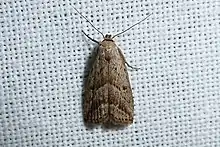| Hypenodes humidalis | |
|---|---|
 | |
 | |
| Scientific classification | |
| Domain: | Eukaryota |
| Kingdom: | Animalia |
| Phylum: | Arthropoda |
| Class: | Insecta |
| Order: | Lepidoptera |
| Superfamily: | Noctuoidea |
| Family: | Erebidae |
| Genus: | Hypenodes |
| Species: | H. humidalis |
| Binomial name | |
| Hypenodes humidalis | |
| Synonyms | |
| |
Hypenodes humidalis, the marsh oblique-barred, is a moth in the family Erebidae. The species was first described by Henry Doubleday in 1850. It is found in most of Europe and across the Palearctic to Siberia.[2]
The wingspan is 14–15 mm. The forewing is whitish ochreous, irrorated (sprinkled) irregularly with brown and dark fuscous. The inner line is indistinct; the outer line is irregular, oblique, dark fuscous and posteriorly whitish edged. The cellspot is small, dark, outwardly whitish edged. The subterminal line is straight, whitish, ill-defined and preceded by fuscous suffusion, running to the apex. The hindwing is grey.[3] Adults are on wing from the end of May to the beginning of October.[4]
The larvae possibly feed on Juncus and/or Carex species.[5] The larvae can be found from July to May. The species overwinters in the larval stage. Pupation takes place at the stem of the host plant.
References
- ↑ Fauna Europaea
- ↑ Savela, Markku (5 July 2019). "Hypenodes humidalis Doubleday, 1850". Lepidoptera and Some Other Life Forms. Retrieved 14 March 2020.
- ↑ Seitz, A. Ed., 1914 Die Großschmetterlinge der Erde, Verlag Alfred Kernen, Stuttgart Band 3: Abt. 1, Die Großschmetterlinge des palaearktischen Faunengebietes, Die palaearktischen eulenartigen Nachtfalter, 1914
- ↑ "Moeras-micro-uil Hypenodes humidalis". De Vlinderstichting (in Dutch). Retrieved 14 March 2020.
- ↑ Kimber, Ian. "72.060 BF2485 Marsh Oblique-barred Hypenodes humidalis Doubleday, 1850". UKMoths. Retrieved 14 March 2020.
External links
- "08863 Hypenodes humidalis Doubleday, 1850 - Moor-Motteneule". Lepiforum e. V. Retrieved 14 March 2020.